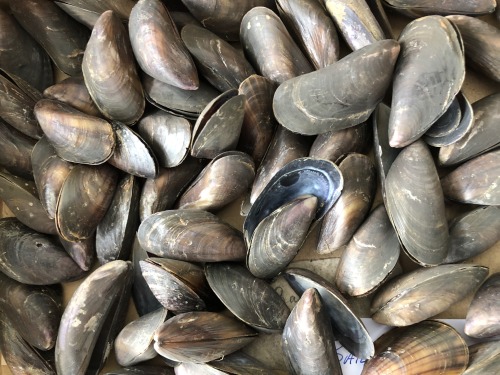#global change
Belgian mussels developed stronger shells
Belgian mussels have developed stronger shells over the last hundred years. More calcareous shells protect them better from crabs’ claws and seagulls’ beaks. These predators have increased significantly in number during the last fifty years. ‘Belgian mussels adapt surprisingly well to new environmental conditions’, says biologist Thierry Backeljau (RBINS). ‘They might be more resilient to climate change than we think.’
An international team of biologists analyzed the calcareous structure of mussel shells that were collected along the Belgian coast this last century. You would expect the shells to become thinner because more acidic seawater - due to the increase in CO2 in the atmosphere - breaks down calcareous matter. But the team observed a marked increase in the calcification of mussel shells.
The main causes of the more calcareous mussel shells are changes in predators. The dog whelk (Nucella Lapillus) disappeared at the end of the seventies, after which the number of crabs and seagulls increased during the 1980s and 1990s respectively. This led to a pressure on mussels to develop thicker shells, protecting better against the crabs’ claws and the seagulls’ pecking beaks. According to the scientists, this might mean that our Belgian mussel populations can better cope with future climate changes than previously thought.
A special collection
The researchers evaluated a total of 268 mussels that were collected between 1904 and 2016 on the breakwaters between Nieuwpoort and Ostend. The specimens collected between 1904 and 1987 are part of the collections of the Royal Belgian Institute of Natural sciences (RBINS). This unique collection of one single species is composed of ‘wet’ specimens (shells and body tissue, preserved in ethanol), and ‘dry’ specimens (shells only). They were collected during monitoring programs over the past century. ‘This mussel collection is unique,’ says biologist Thierry Backeljau (RBINS), co-author of the study. ‘It may sound paradoxical, but to have such an extended collection of an animal that is so ubiquitous is rare. Researchers usually focus on exceptional species.’
Dog Whelks and acidification
The dog whelk is an important predator of mussels in the North Sea. Dog whelks make a small hole in the mussel shell, through which they suck the mussel empty. To do this, they must drill through the dark, organic outer layer of the mussel: the periostracum. Mussels with a thicker periostracum are better protected against this type of predator. This created a selective pressure on mussels, favoring a thicker periostracum. The acidification of the North Sea - which breaks down calcareous matter - led to additional pressure in favor of more periostracum, offering better protection to the underlying calcareous layer.
But as of the late 1970s, things changed. The dog whelk population suddenly declined sharply and even died out locally due to the use of tin based paint on ship hulls, particularly tributyltin hydride (TBT). The selection pressure on mussel populations in favor of more periostracum decreased.
Crabs and seagulls
In the meantime, average spring and summer temperatures of North Sea surface waters continued to rise, in line with global ocean trends. The input of minerals and nutrients from the land also increased steadily over the past sixty years due to the discharge of fertilizers and wastewater into rivers (eutrophication). The result: an increase in the amount of algae and thus a greater food supply for all kinds of organisms, including the larvae of decapods such as crabs and lobsters. As a result - helped by overfishing of cod, which feeds on those larvae - the number of crabs and lobsters skyrocketed from the 1980s.
Just like the dog whelk, crabs and lobsters are fond of mussels, which they crush with their claws. Protection by a periostracum makes little difference against this, but a stronger, more calcareous shell does. Moreover, depositing calcium requires less energy than producing a periostracum. Thus, a new selection pressure arose, in favor of more calcareous shells.
This selective pressure was reinforced by the exponential population growth of seagulls in the 1990s, due to the increased number of decapods. The breeding season of seagulls (May and June) coincides with the peak of decapods, which are an important food source for the chicks. But seagulls also eat mussels and increased the selection pressure in favor of a calcareous, solid shell.
Hope for the future?
This study shows that the global effects of climate change, such as ocean acidification, do not simply apply on a local scale. Complex, local changes in ecological conditions can lead to biological outcomes that appear to conflict with predictions on a global scale.
‘The Belgian mussel populations seem able to adapt their shell formation to a wide range of local selection pressures and perturbations’, says Backeljau. ‘This gives hope for the future: mussels may be better armed against climate change than we thought.’ This research also illustrates the importance of natural science collections, such as those of the RBINS, in the study of, and fight against, climate change. ‘Collections and archival specimens help us investigate long-term effects of changes in the environment, which is difficult with experimental studies. It is a powerful research method that, as shown here, can yield surprising results and help us get a clearer picture of historical ecological changes’, concludes Backeljau.
The study was published in Global Change Biology.
Post link



